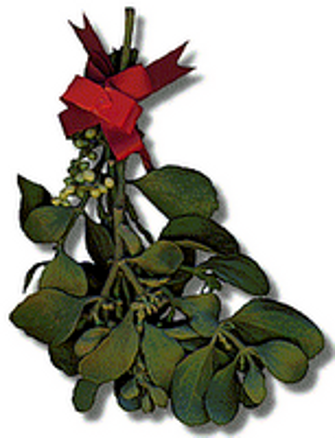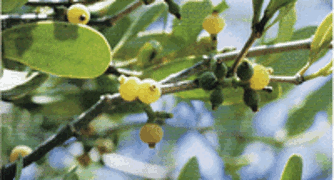Some Lovely Misteltoe Pictures and Clipart

Picture of Mistletoe with its beautifully decorative berries

Mistletoe Clip Art

Mistletoe Picture
|
But the richest legends concerning mistletoe come to us from the Gauls who
considered it a sacred plant. The Druids attributed miraculous virtues in the
plant, capable not only of curing some diseases, but also of immunising against
poisons, combatting interfility and protecting against sorcery. During the
sixth night of the winter solstice, a druid dressed in white was made
responsible for picking the sacred mistletoe from the oak tree with a gold
billhook. He would place it a sheet of white flax whilst saying in Celtic "O
Ghel an Heu", which literally means "that the wheat germinates".
History also tells that enemies who crossed under mistletoe berries had to
observe a one day truce before resuming the battle. From those origins it's
quite certain that the custom of kissing under mistletoe
suspended from the ceiling as a sign of friendship arose.
Mistletoe finds a symbolic meaning in Germanic mythology. Odin, king of the
Gods, and his wife, Frigg had a beautiful son called Balder. Frigg discovered
that Balder was having terrible dreams foreseeing his own death. Fearing for
her son, Frigg had all elements of the earth swear that they would not harm
Balder....all elements that is except one particular thing...Frigg had not
asked the mistletoe because she had considered it to be too young, small and
insignificant.
After Frigg had obtained the oath from the elements not to harm Balder, the
Gods amused themselves, testing his invulnerability by throwing various objects
at him . Everything would bounce off, leaving Balder completely unharmed.
The mischievous God Loki , disguised as an old lady, visited Frigg however,
and found out from her about he fact that she had not got the mistletoe to
swear the oath.
Loki created a spear from a sprig of mistletoe, and convinced Balder's blind
brother Hödr to throw the sprig at Balder, to join in with the other Gods at
testing Baldur's invincibility. Balder threw, thinking that the sprig would
harmlessly bounce off Baldur like everything else was apparently doing, but the
mistletoe killed Baldur. It was Balder's "Achilles' heel", because all other
elements of the Earth had sworn to do nothing to harm the beautiful, young God,
yet the mistletoe had not taken the oath.
Other Anglo-Saxon legends exist, but apartt from the story of Baldur, the
mistletoe is normally associated in these legends with happiness, prosperity,
fruitfulness, fertility and long life.
The Mistletoe Plant and Botany
Mistletoe is a small hemiparasitic tree shrub. In other words, it steals
wter and mineral salts from its host, but can produce its own chlorophyll and
sugars. It follows the growth of the bark by moving its suction organ back
every year, thus enabling it to suck the sap on which it feeds, up to the final
dieback of the shaft. These big shrubs of 50cm diameter, which are spotted from
far away in winter, have a persistent foliage. The simple and rounded, leaves
arranged in pairs, are very decorative. The fruits, of a viscous white colur,
are at the origin of the Latin name of one particular species of the the plant,
Viscum album, the European or Common Mistletoe. A very resistant glue was made
in the past, known as bird lime. Birds are very fond of the berries and are
responsible for the spread of mistletoe from tree to tree.
Trees
Mistletoe is a parasite which impoverishes the tree on which it grows by
sucking its sap. It particularly likes apple trees, poplars, limes, pear trees
and hazels, but never attaches itself to beech trees and plane trees. The
presence of mistletoe on oaks is very rare, which made it even more precious in
the eyes of ancient Druids. There are no effective chemicals to protect a tree
against mistletoe, and the only means to combat its blight is to cut the entire
branch sufficiently far from the point of attachment to avoid a regrowth.
Prevention against mistletoe today occurs by selecting resistant cultivars.
Medicinal Uses
In the past, mistletoe was used by herbalists to treat on epilepsy, nervous
problems and whooping cough. Toxic in high doses, mistletoe is the subject
today of scientific researches which are trying to demonstrate its beneficial
effects on the immune system and in the fight against hypertension. Recent
researches could highlight the capacity of the ability of mistletoe to inhibit
cancerous tumours...maybe the Druids were correct after all!
Mistletoe as Decoration
Branches of mistletoe make beautiful New Year and Christmas decorations,
which keep for a long time, provided the stems are soaked in a vase of
water.
Tools to pick Mistletoe
In the absence of a gold billhook, a good pair of secateurs will enable you
to easily pick sprigs of mistletoe.
|
